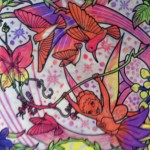Hannah LOVES to colour. I love that she loves to colour. I don’t love that she loves to colour everything – the carpet, the television….. Turns out even the washable markers do not come out of carpet.
So we got some of those Crayola markers that don’t make a mark unless on the special paper. I have to say I love them – they bring back childhood memories of workbooks with secret messages and secret pens. They really do make no mess and the effect on the paper is like a watercolour painting. In fact, I have to replace the books more frequently than I should because they’re awfully fun.
Of course this wouldn’t be a mommiologist post if I didn’t confess to something extremely nerdy. It’s driving me nuts trying to figure out how they work. I first wondered if it was an acid-base thing, because you can have very sensitive litmus papers that would react to a narrow range of pH, so you could have a wide range of colours over a safe range of pH. Yeah, that’s right, after Hannah went to bed I actually tested her Crayola colour paper. I put some lemon juice, vinegar (both pH of roughly 2) and water (pH average 7.7). Nuffin. So, not acid-base.
Redox reactions make some pretty interesting colours and we use them a lot in the lab in indicator plates. But I couldn’t imagine redox dyes being that easy to work with in this situation. And maybe a little dangerous.
Crayola, predictably, did not have anything useful on their site, but the magic of the interweb did find me this tidbit:
“Good morning! As it happens, my good friend Constantine’s father is the inventor and patent holder of the compounds that make Color Wonder work. He worked closed with Binney & Smith (the folks who make Crayola products) to develop the Color Wonder line. I dropped him an e-mail last night to see if he could get the information for you. The actual compounds themselves are kept secret, but Mr. G. was able to provide a general explanation: “This is caused by the interaction between two complementary phenol-formaldahyde compounds, similar to the technology that is used on carbonless copy paper (those two-part receipts that are used for credit card sales). The actual ingredients are a proprietary secret, but the general idea is that the paper is coated with one chemical, and the marker tip contains the other. When they mix they change color (kinda like phenolphthalien, a solution of which is normally clear but which turns color in the presence of a base or acid). The chemical in the marker tip is nonreactive with most other surfaces, which is why you can’t use the markers to draw on walls or clothing (or people). The potential still exists for the markers to draw in color, but the chemical activator isn’t present to make it happen.” Hope that helps!””
So there you go. Interesting chemistry. Safety? Reading about formaldehyde did not make me happy but there was nothing new there. I’m fairly certain that any modern home contains far more formaldehyde containing products than my daughter’s markers, and though the actual recipe is a trade secret, I did find the MSDS sheet for them, and was suitably reassured.
So I’m going to stop neglecting my daughter to write about her, and go colour.



